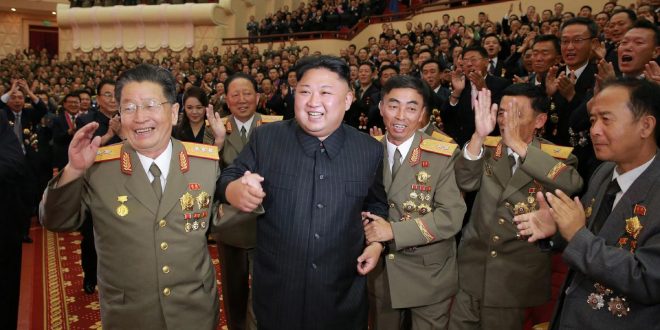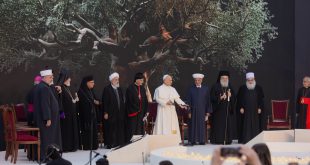If a conflict between North Korea and the United States suddenly broke out, U.S. troops in South Korea would be “outnumbered” and undersupplied, warns Lt. Gen. Jan-Marc Jouas, the former deputy commander of U.S. Forces in Korea.
“The 28,500 U.S. Armed Forces personnel in South Korea are vastly outnumbered by North Korean forces, as well as [South Korean] forces that will conduct the overwhelming majority of the fighting. Unlike every conflict since the last Korean War, we will not be able to build up our forces prior to the start of hostilities,” Jouas wrote in a November 7 letter obtained by Newsweek to several Democratic members of Congress. It’s estimated North Korea has roughly 1.2 million troops.
Jouas’s letter is addressed to Representatives Ted Lieu and Ruben Gallego and Senator Tammy Duckworth, all veterans of the U.S. military who’ve recently expressed grave concern over President Donald Trump’s rhetoric and stance toward North Korea.
From January 2012 to December 2014, Jouas was intimately involved in formulating plans to counter a North Korean attack on South Korea. “This threat was the most dangerous I’d faced since the end of the Cold War, and planning for it the most challenging problem I’d encountered in my 35-year career,” he said.
According to Jouas, it would take months for the necessary U.S. reinforcements, supplies and equipment to reach the Korean Peninsula. Once the troops finally arrive, Jouas added, “they may well find their bases subject to attack by conventional or chemical weapons, which will further delay their entry into the war.”
Jouas also highlighted the risk a conflict would pose to both South Korean and American civilians living in the region. He said it would take “days” to eliminate North Korean artillery, rockets and missiles that threaten the South Korean capital of Seoul, which is home to 25 million people. Meanwhile, “an enormous casualty and evacuee crisis will develop and include over a hundred thousand non-combatant Americans, many of who will turn to U.S. forces to get them off the peninsula,” Jouas added.
He also warned that the protection of South Korean civilians and evacuation of U.S. civilians would be “significantly complicated” by the “expected use” of nuclear and chemical weapons by Kim Jong Un’s regime.
Finally, Jouas emphasized any military action against North Korea by the U.S., “no matter how limited,” would likely spark a full-scale war and be unlikely to “completely eliminate North Korea’s nuclear capabilities.”
Jouas’s letter comes not long after the Pentagon said a ground invasion of North Korea would be necessary in order to eliminate its nuclear arsenal. This assertion was prompted by a request from Lieu and Gallego directed at Defense Secretary James Mattis for a detailed report on what a conflict with Kim’s regime would look like.
Lieu, who served in the U.S. Air Force and was at one point stationed in Guam, told Newsweek what really “jumped out” to him about the letter was how clear it outlines the logistical issues the U.S. military faces in terms of dealing with North Korea. Unlike conflicts in the Middle East, the U.S. “can’t just send over troops and equipment right now because that would provoke a North Korean attack,” Lieu said. “It would take many days to get rid of North Korea’s artillery and all their other weapons. In the meantime, a lot of people are going to die.”
The California congressman also noted that although the U.S. has an extremely advanced military and “the best air force in the world,” its advantage in this regard would essentially be eliminated once “North Korea sends their massive army down to population centers in South Korea.” Seoul is just 35 miles from the demilitarized zone that separates North and South Korea. If the North Korean military broke through and reached the capital, U.S. and South Korean troops would likely find themselves overwhelmed and without air support.
The Pentagon has not given specifics on how many casualties might result from a war between the U.S. and North Korea, but a recent assessment from the Congressional Research Service estimated as many as 300,000 could die in the first few days of fighting, even without the use of nukes. Experts have also warned a U.S. ground invasion could turn “very bloody, very quickly.”
As Kim’s regime has refused to step away from its nuclear program and ramped up its long-range missile tests, Trump has issued a number of bombastic threats toward the reclusive nation. In late September, for example, the president warned North Korea it would be met with “total destruction” if the U.S. was forced to defend itself or its allies. Some have accused Trump of deliberately pushing the U.S. toward war.
During a trip to Asia in early November, Trump softened his tone and adopted a somewhat more diplomatic approach, calling for North Korea to “come to the table” and find a peaceful settlement to the two countries’ differences. Pyongyang, however, responded by stating it’s heard enough from “mad dog” Trump and is seemingly disinterested in negotiating.
Newsweek
 Lebanese Ministry of Information
Lebanese Ministry of Information



